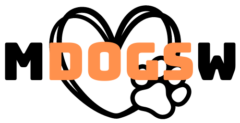Okay, folks, let’s be honest. How many times have you rolled your eyes while Dog Brush? I bet you were thinking, another pile of fur on the floor. But here’s the thing: did you know a regular brushing routine can work wonders for your furry friend – and save you some cleaning headaches too? It’s true!
Think about it a good brushing session will help control shedding (yay for less furry tumbleweeds!). But it also keeps your dog’s skin healthy, makes their coat super shiny, and gives you bonding time for extra cuddles. And who wouldn’t want that?

Brushing Benefits Beyond Shedding
Why Brushing Rocks
- Healthy Skin and Shiny Coat: Imagine your dog’s fur as a protective superhero suit! Brushing helps spread natural oils from the skin throughout their coat, promoting shine and water resistance. Plus, it removes dead skin cells to prevent dryness and itchiness.
- Boosted Blood Flow: Who doesn’t love a good massage? Well, gentle brushing acts similarly, improving blood circulation and promoting overall body health for your pup.
Bonding Time: Regular brushing can be a quality time activity for you and your dog. It builds trust and helps anxious pups relax. Think of it as their own personal spa day! - Bug Patrol: Brushing is like a full-body inspection for your pooch. You can spot fleas, ticks, or even those pesky grass awns before they become a bigger problem. Early detection for the win!
Think Your Dog Can Skip Brushing?
Now, don’t get me wrong, short-haired cuties might not need brushing daily. But everyone needs it sometimes! Neglecting brushing can lead to uncomfortable matted fur, hidden skin problems, and some seriously unhappy campers (that means your dog, not the fluffy marshmallows we roast).
Decoding Your Dog’s Coat
Furry Mysteries: What Kind of Coat Does Your Dog Have?
Does your dog’s fur feel more like a soft sweater, a wiry mop, or an explosion of fluff? Understanding your dog’s coat type is the secret to picking the perfect brush for the job! Let’s break down the common categories:
- Short and Smooth: Think Dachshunds, Boxers, and Chihuahuas. These low-maintenance coats still shed, but they’re usually easy to manage with quick brushing sessions.
- Medium-Length: This is where Golden Retrievers, Aussies, and many mixed breeds belong. They have a thicker coat with a bit more fluff, needing some regular detangling.
- Long and Luxurious: Afghan Hounds, Collies, and Samoyeds sport these stunning locks. Beautiful, yes, but they need dedicated brushing to avoid major matting disasters.
- Double-Coated: Huskies, Malamutes, and German Shepherds rock a topcoat and a fluffy undercoat. Shedding season? Be prepared – it’ll be like a snowstorm in your living room!
- Curly Coats: Poodles, Bichon Frises, and some Doodle mixes have their own charm (and grooming needs!). They don’t shed much, but mats can form easily with those tight curls.
- Wiry Coats: Schnauzers, Terriers, and similar breeds have a coarse, bristly coat. They often need special brushing and stripping tools to manage those wiry locks.
Get Your Detective Hat: Dog Coat Quiz Time!
Want a fun way to figure out your dog’s coat type? Try this quick quiz:
Is your dog’s fur short, medium, or long?
Does it have an undercoat (fluffy underlayer)?
Is their coat smooth, curly, or wiry?

The Amazing World of Dog Brushes
Brush Up on Your Options: The Essential Toolkit
Let’s be real, walking into the pet store’s brush aisle can feel like entering a jungle! There are pointy things, soft things, and brushes with weird names. But don’t worry, I’m here to be your guide! Let’s meet the basic brush types:
- De-shedding Tools: The shedding champion! These brushes usually have a row of fine metal teeth designed to safely reach through the top layer of fur and grab loose undercoat. Perfect for double-coated breeds and serious shedders.
- Slicker Brush: Like a hairbrush for dogs! These have closely spaced wire pins that are great for removing mats and tangles and work on most coat types. Think of it as your everyday workhorse brush.
- Undercoat Rake: Designed specifically for dogs with thick undercoats. The wide comb-like teeth reach down to remove loose fur and prevent mats deep in the coat. It’s like magic for shedding season!
- Bristle Brush: The gentle giant of brushes! Soft bristles provide a finishing touch for smoothing fur or a relaxing brush session for short-haired or sensitive pups.
Beyond the Basics: Specialized Brushes for the Win
Ready for a little insider knowledge? Here are a few brush types that will up your grooming game:
- Shedding Gloves: These double as petting tools! The rubber nubs work wonders on short coats, and nervous dogs often love the massage-like feel of these.
- Bath Brushes: Make bath time more effective! These silicone brushes can be used with shampoo for a deeper clean and a gentle massage that helps loosen dead fur.
- Massage Brushes: These focus purely on the good feels. Some dogs (especially short-haired or anxious ones) might find traditional brushes uncomfortable. Massage brushes soothe and can help build positive associations with grooming time.

The Perfect Match: Brush Selection Guide
Unlock the Secrets to Happy Brushing: Your Dog’s Ideal Brush Team
Choosing the right brushes makes all the difference between a tangled mess and a happy, well-groomed doggo. Here’s a breakdown of the best brush picks depending on your dog’s coat type:
| Coat Type | Primary Brush | Secondary Brushes | Helpful Extras |
| Short and Smooth | Shedding Glove/Curry Comb | Bristle Brush | Bath Brush |
| Medium-Length | Slicker Brush | Undercoat Rake (if needed), Bristle Brush |
Detangling Spray
|
| Long and Luxurious | Slicker Brush, Undercoat Rake | Bristle Brush |
Detangling Spray, Dematting Comb
|
| Double-Coated | De-shedding Tool, Undercoat Rake | Slicker Brush | – |
| Curly Coats | Slicker Brush, Pin Brush | Detangling Comb |
Detangling Spray
|
| Wiry Coats | Slicker Brush, Stripping Comb | Bristle Brush | – |
Table: Brush Recommendations by Coat Type
Wait, Multiple Brushes?!
why would you ever need more than one brush? Think of each brush as having its own grooming superpower! To tackle shedding season, a de-shedding tool is your hero, but for everyday detangling, a slicker brush will be your go-to. Puppies need a gentler touch, so start with soft-bristle brushes or even a massage brush to get them used to the grooming routine. And if your dog has sensitive skin, look for softer bristles or opt for an extra-gentle massage brush. Finally, remember that a big dog doesn’t always need a giant brush! Focus on finding a brush head size that’s comfortable for you to handle and consider a sturdier handle for those big dog brush sessions.

Grooming Like a Pro: Techniques & Tips
Master the Art of Brushing: Tips for a Happy Dog and a Tangle-Free Coat
Ready to unleash your inner dog-grooming guru? Start slow and go steady – especially with puppies or dogs new to grooming – focusing on short sessions filled with treats and praise! To keep things tangle-free, brush from the roots of the fur outward, working gently to prevent matting issues. If you hit a tangle, don’t yank! A detangling spray and working on small sections at a time is key, and a wide-tooth comb can be your best friend. Always brush in the direction of your dog’s hair growth, as going against it can be uncomfortable. Finally, remember that areas like their face, belly, and legs may need extra gentleness and possibly a softer brush.
Grooming Frequency: How Often is Enough?
Now, let’s talk about how often to get those brushing sessions in! Here’s a quick guideline:
- Short Coats: 1-2 times a week
- Medium Coats: 2-3 times a week
- Long Coats: Daily brushing might be needed to prevent mats
- Double Coats: Frequent brushing year-round, but especially during shedding season
Important: These are just a starting point! You might need to adjust based on your dog’s individual coat and shedding habits.
Turn Brushing into Bonding Time
Brushing doesn’t have to be a chore. If your dog is nervous, start slow, use calming treats, and keep sessions short. With patience and positive association, brushing time can be a chance to relax and bond with your furry best friend!

Brush Care and Keeping it Going
Happy Brushes, Happy Dogs: Cleaning and Maintenance Tips
Think of your brushes as an investment in your dog’s well-being! To keep them in top shape, give them some regular TLC. Always remove loose fur after each brushing session, as hair buildup can make brushes less effective (and kinda gross). Every few weeks, give your brushes a deeper clean with soapy water, ensuring they dry fully to prevent rust or mold. Finally, regularly check for bent bristles, loose handles, or any signs of wear and tear. Worn-out brushes can irritate your dog’s skin, so don’t hesitate to replace them when needed!Want to make your grooming routine a little greener? Check out our guide Sustainable Dog Grooming Tips. You’ll find easy ways to reduce waste, from choosing an eco-friendly brush to simple DIY solutions that work even for puppies yours and the planet.
Eco-friendly Brushing: Small Choices Make a Difference
Want to make your grooming routine a little greener? Look for brushes made from sustainable materials like bamboo or recycled plastics. You can also repurpose old combs or brushes with sturdy bristles for occasional use, giving them a new life! And if you have a compost pile, dog fur can actually be added (in moderation) for extra nutrients – who knew brushing could help your garden too?
Conclusion
You now have the knowledge to choose the perfect brushes for your dog’s coat and keep them looking and feeling their best! Remember, consistency is key. Regular brushing will not only make your dog a shedding superstar but also strengthen your bond and keep their overall health in check. Now go forth and brush – your furry friend thanks you!
FAQ
What is the best brush for shedding?
De-shedding tools are your shedding season heroes! Their fine metal teeth are designed to reach through the topcoat and safely remove loose undercoat. Look for one designed for your dog’s coat length.
How do I brush my dog if they don’t like it?
Start slow! Short sessions with lots of treats and praise make it positive. If your dog is very anxious, try a soft massage brush first. With patience, most dogs learn to enjoy brushing time.
Can I use a human hairbrush on my dog in a pinch?
It’s not ideal. Dog brushes are designed for their coat types. Human brushes usually lack the right spacing or firmness to be effective and could even irritate your dog’s skin.
How often should I replace my dog’s brushes?
Check your brushes regularly. When bristles become bent, the handle feels loose, or they seem less effective, it’s time for a replacement. Worn brushes can scratch your dog’s skin!
Do large dogs need special brushes?
Got a big dog with a big coat? Don’t worry, we’ve got you covered! Look for brushes with wider heads and sturdy handles for easier grooming. You may also need a combination of brushes, such as a detangling tool for heavy shedding and a slicker brush for everyday detangling.

Healthy dogs mean happy dogs, and that makes me happy! I’m here to share all the tips for keeping your best furry friend in top shape, from puppyhood to their golden years.


